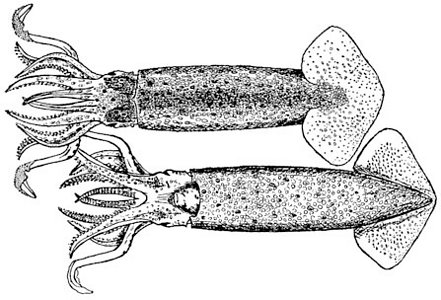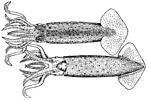Berryteuthis anonychus
Tsunemi Kubodera, F. G. Hochberg, and Richard E. YoungIntroduction
 image info
image infoFigure. Ventral view of B. anonychus, ventral view of male, 69 mm ML, preserved. Photograph by R. Young.
Berryteuthis anonychus is a small, muscular species reaching a maximum size of 150 mm ML (Nesis, 1982/87). This squid has been repeatedly captured by dipnet at the surface at night. B. anonychus is unusual for a gonatid in lacking nearly all hooks on arms and tentacle clubs.
Diagnosis
A Berryteuthis ...
- without hooks on arms in males.
- with few weakly developed hooks at bases of arms I-III in females.
Characteristics
- Arms
- Marginal arm suckers pedicillate; sucker rings with 6-8 truncate, rectangular teeth.
- Arms of males without hooks; sucker rings in medial 2 rows of basal two-thirds to three-quarters of arms consist of dorsal and proximal lips not distinct and separate teeth.
- Females with 3 pairs of small, hook-like suckers present in medial rows at proximal region of arms; arm hooks develop at mantle lengths between 35-60 mm ML.
- Hectocotylized arms not present.
 image info
image info  image info
image info Figure. Oral view of arm suckers and hooks of B. anonychus. Left - Medial hook-like sucker, basal portion of arm III, female. Middle - Medial sucker, basal two thirds of arm III, male. Right - Marginal sucker from arm III. Drawings from Pearcy and Voss (1963).
 image info
image info  image info
image info Figure. Oral view of arm suckers of B. anonychus, holotype. Photographs by R. Young.
 image info
image info
Figure. Oral view of arm bases of B. anonychus showing two hook-like suckers near the proximal end of each arm. Photograph by R. Young.
- Head
Comments
Information on characters listed above taken from Pearcy and Voss (1963).
More details of the description of B. anonychus can be found here.
Life History
Paralarvae can be identified by the dorsal-head chromatophore pattern which is Type II,2 (three transverse rows of chromatophores with one chromatophore in the anterior row, two in the middle row and three in the posterior row and two additional chromatophores on the posterolateral regions of the head but are visible dorsally); the mantle has 16-25 dorsal chromatophores (Jorgensen, 2006).
 image info
image infoFigure. Dorsal views of the chromatophores of a B. anonychus paralarva, 5.5 mm ML, Gulf of Alaska. Left - Head. Note the two additional dark chromatophores on the posterolateral corners of the drawing. Right - Paralarva. Drawing from Jorgensen (2006).
Distribution
Type locality: Eastern North Pacific Ocean, USA, off Oregon, 45 27.0'N, 125 15.6'W, surface (0 m). image info
image infoFigure. Distribution of B. anonychus. Dark pink area indicates known range; light pink area indicates inferred range. Chart modified from Okutani, et al. (1988).
References
Jorgensen, E. M. 2006. Identification, distribution and relative abundance of paralarval gonatid squids (Cephalopoda: Oegopsida: Gonatidae)from the Gulf of Alaska, 2001-2003.Journ. Molluscan Studies. In Review.
Katugin, O.N. 2004. Squids of the family Gonatidae from the North Pacific Ocean and their genetic differentiation: controversial issues in the systematics and phylogeny. Ruthenica, 14(1): 73-87 [In Russian, English summary]
Katugin, O.N., G.A. Shevtsov, M.A. Zuev, A.M. Berkutova and E.V. Slobodsky. 2005. Spatial and seasonal distribution of the squid Okutania anonycha (Pearcy et Voss, 1963) (Cephalopoda: Gonatidae) in the northwestern Pacific Ocean and adjacent areas. Ruthenica, 15(1): 65-79.
Lindgren, A.R., O.N. Katugin, E. Amezquita and M.K. Nishiguchi. 2005. Evolutionary relationships among squids of the family Gonatidae (Mollusca: Cephalopoda) inferred from three mitochondrial loci. Molecular Phylogenetics and Evolution, 36: 101?111
Nesis, K.N. 1973. Taxonomy, phylogeny, and evolution of squids of the Family Gonatidae (Cephalopoda). Zoologicheskij Zhurnal, 52(11): 1626-1638 [In Russian, with English summary].
Nesis, K.N. 1997. Gonatid squids in the subarctic north Pacific: ecology, biogeography, niche diversity and role in the ecosystem. Advances in Marine Biology, 32: 243-324.
Nesis, K. N. (1982). Abridged key to the Cephalopod Mollusks of the World's Ocean. 385+ii pp. Light and Food Industry Publishing House, Moscow. (In Russian.). Translated into English by B. S. Levitov, ed. by L. A. Burgess (1987), Cephalopods of the World. T. F. H. Publications, Neptune City, NJ, 351 pp.
Okutani, T., T. Kubodera and K. Jefferts. 1983. Diversity, distribution and ecology of gonatid squids in the subarctic Pacific: a review. Bull. Ocean Res. Inst., Univ. Tokyo, No. 26 (1): 150-192.
Pearcy, W. G. and G. L. Voss. 1963. A new species of gonatid squid from the northeastern Pacific. Proc. Biol. Soc. Wash., 76: 105-112.
About This Page
Tsunemi Kubodera

National Science Museum, Tokyo, Japan
F. G. Hochberg

Santa Barbara Museum of Natural History, Santa Barbara, California, USA
Richard E. Young

University of Hawaii, Honolulu, HI, USA
Page copyright © 2006 , F. G. Hochberg, and Richard E. Young
- First online 31 May 2006
- Content changed 31 May 2006
Citing this page:
Kubodera, Tsunemi, Hochberg, F. G., and Young, Richard E. 2006. Berryteuthis anonychus . Version 31 May 2006. http://tolweb.org/Berryteuthis_anonychus/26874/2006.05.31 in The Tree of Life Web Project, http://tolweb.org










 Go to quick links
Go to quick search
Go to navigation for this section of the ToL site
Go to detailed links for the ToL site
Go to quick links
Go to quick search
Go to navigation for this section of the ToL site
Go to detailed links for the ToL site